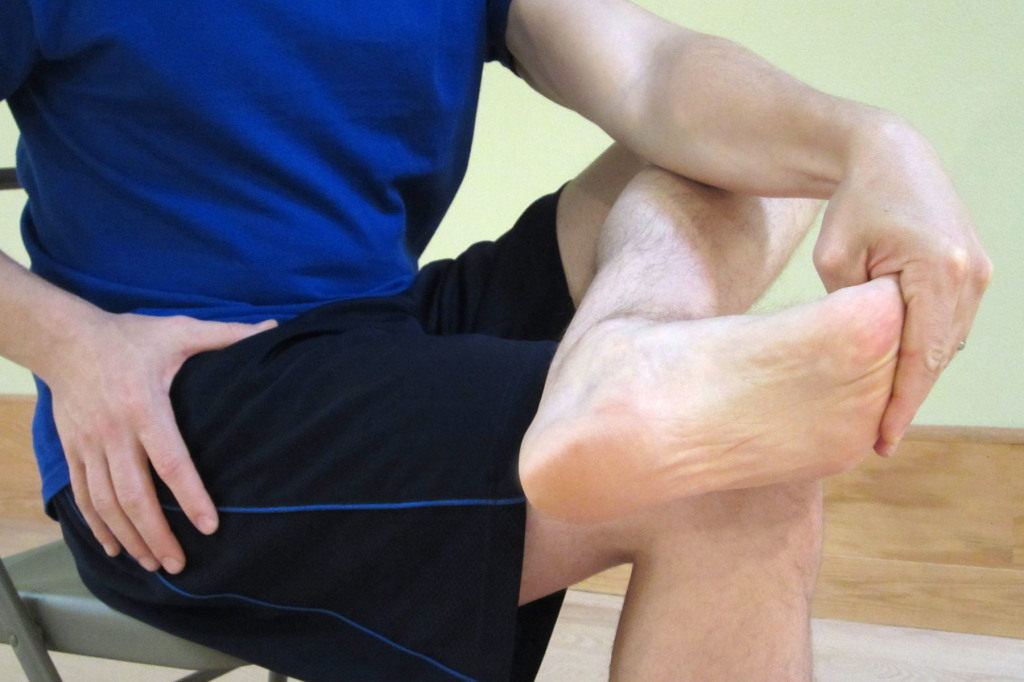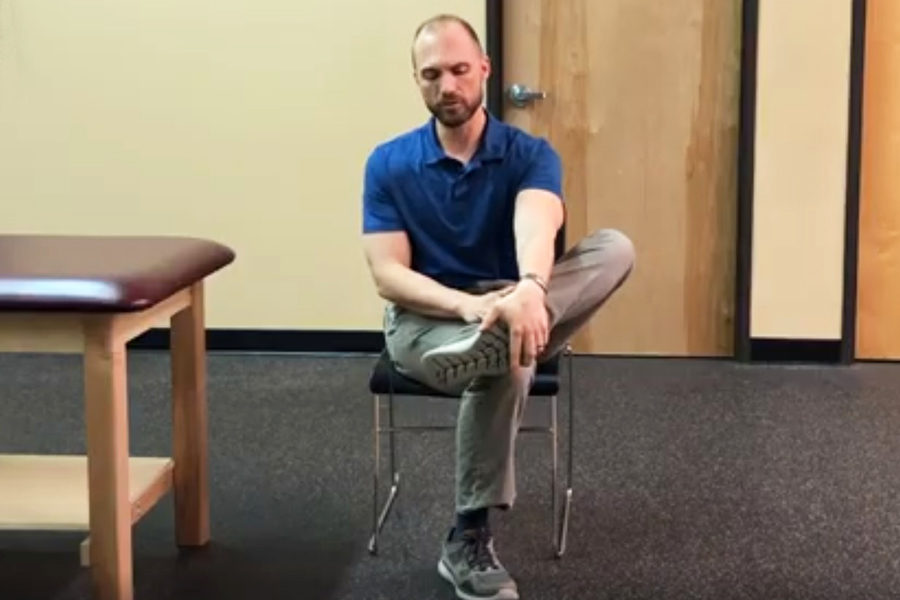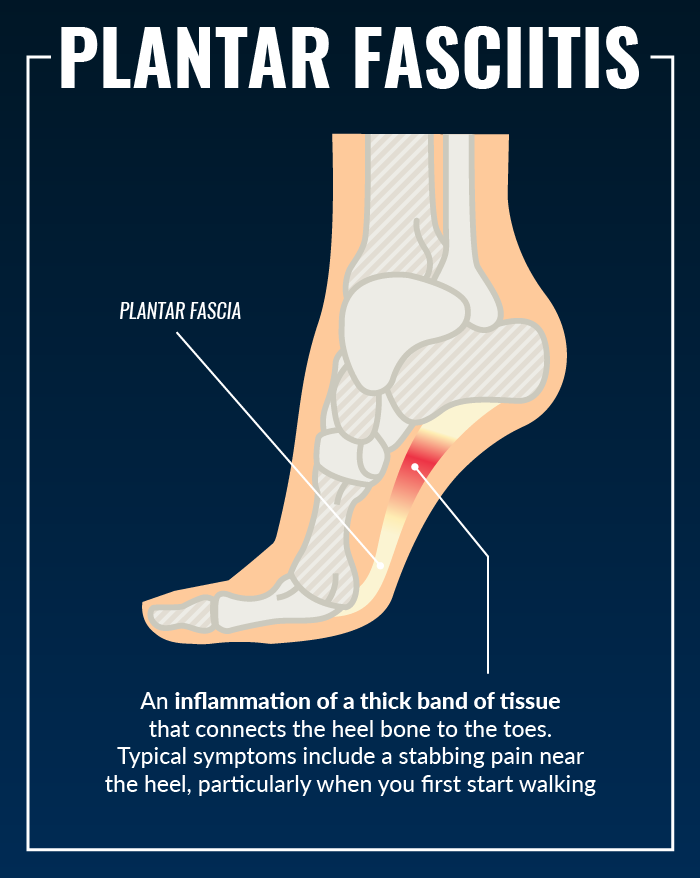Plantar fasciitis is a very painful and potentially very debilitating condition. It’s one of the most common causes for heel and bottom of the foot pain. The plantar fascia is essentially a band of connective tissue (a ligament) which runs the length of your foot from your heel to your toes. It helps to support the arch of your foot by using “windlass mechanism” to make the foot more rigid and aid in the foot’s ability to transfer force and push off when walking or running. In the case of plantar fasciitis, the fascia on the bottom of the foot becomes swollen and irritated and may cause pain when you stand and/or walk. It’s typically at its worst in the morning with your first several steps after sleeping. Plantar fasciitis is also more common the older a person becomes.
Risk factors for developing plantar fasciitis include:
- Excessive foot pronation. Your feet tend to roll inward as you stand, walk, and/or run.
- Either excessively high arches or overly flat feet.
- Spending long periods of time standing or walking.
- Spending long periods of time on hard surfaces, such as concrete.
- Obesity
- Your shoes don’t fit well or the shoe is worn out.
- You have transitioned too quickly from a more built up running shoe into a minimalistic style.
- Poor ankle mobility, particularly excessive tightness in the Achilles tendon or calf muscles.
- Poor foot muscle strength, particularly the foot intrinsic muscles which help to support the arch of the foot.
Plantar fasciitis typically begins as a mild discomfort which grows steadily and quickly to the point that a person may struggle to walk, stand, or run. Plantar fasciitis may occur after a specific event. The plantar fascia could be over stretched due to a slip. It could occur after an overzealous training day in unfamiliar circumstances, such as running barefoot in the sand.
Fortunately, plantar fasciitis doesn’t always require formal medical treatment. The key is to intervene quickly to identify the actual cause or causes that led to the inflammation and irritation. The recommended treatment is the same whether or not the plantar fasciitis developed over time or due to a specific event.

How to Self-Treat Plantar Fasciitis:
- Begin your rehabilitation. Start with these Plantar Fasciitis Rehabilitation Exercises. Complete with instructions and photos, this guide outlines how to safely self-treat your plantar fasciitis. Stretch your calves as tight Achilles tendons and calf muscles can cause excessive strain on the plantar fascia, which increases your risk of pain. Stretch your plantar fascia by performing stretches prior to standing or walking upon morning waking and after any prolonged sitting.
- Mobilize the tissue. Depending on how aggressive you want to be, a tennis ball, lacrosse ball, or golf ball can be used to mobilize the tissue. I recommend mobilizing once or twice per day for 2-3 minutes. Then perform additional stretching of the plantar fascia and calves.
- Use ice. My favorite technique for icing this area is to use a frozen water bottle. Roll your foot over the bottle for 3-4 minutes until your foot starts to feel numb and the pain subsides. It’s possible to frost bite your foot, so be mindful of the length of time you’re icing.
- Strengthen your foot and ankle complex. Weakness in the foot and ankle muscles (as well as the smaller foot intrinsic muscles) can lead to excessive strain on the plantar fasciitis. I recommend initiating a complete ankle/foot strengthening protocol. Please refer to Ankle Resistance Exercises.
- Improve your balance. Poor balance is often associated with muscle weakness in the foot and ankle as well as the knee and hip musculature. Weakness and balance deficits can lead to poor foot mechanics, which can lead to excessive strain on the plantar fascia. Improving your balance can help reduce the risk of plantar fasciitis and is an important part of the rehabilitation. Please refer to Improving Balance by Using a Water Noodle.
- Start a supplement. I am a supporter of natural supplements and remedies. Many supplements include herbs which are designed to help reduce inflammation. Phenocane Natural Pain Management combines the following: Curcumin, an herb that reduces pain and inflammation; boswellia, a natural COX2 inhibitor that also reduces pain and inflammation; DLPA, an amino acid that helps to increase and uphold serotonin levels in the brain; and nattokinase, an enzyme that assists with blood clotting and reduces pain and inflammation. If you are taking blood thinner medication, please consult with your physician prior to taking Phenocane Natural Pain Management.
- Use a plantar fasciitis night splint. Although a little cumbersome and annoying, night splints can be helpful. While lying, the natural tendency is to flex the foot to point your toes (plantarflex). This position causes the plantar fascia to shorten and tighten, which explains the pain you might experience during the first few steps after sleeping or resting. The night splint helps you to heal by maintaining a neutral position which doesn’t allow the fibers to shorten.
While you’re self-treating your plantar fasciitis, you’ll likely need to modify your exercise or running program. It’s an excellent time to focus on cross training activities. I recommend following this protocol for two to three weeks.
If you’re not experiencing significant relief upon progressing into your exercise program, please consult a medical professional. I recommend a physical therapist who specializes in feet or who works with athletes for the treatment of plantar fasciitis. The American Physical Therapy Association offers a wonderful resource to help find a physical therapist in your area.
Has a specific treatment for plantar fasciitis helped you? Which treatments haven’t worked for you? Additional discussion can help others to manage this condition more effectively. Please leave your comments below.
Looking for that exercise or book I mentioned in a post? Forgot the name of a product or supplement that you’re interested in? It’s all listed in the new Resource Guide. Check it out today!
If you have a question that you would like featured in an upcoming blog post, please comment below or submit your question to contact@thePhysicalTherapyAdvisor.com. Be sure to join our growing community on Facebook by liking The Physical Therapy Advisor!



